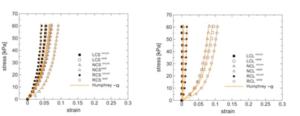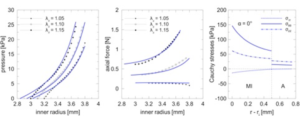Background
To perform realistic finite element simulations of cardiovascular surgical procedures (such as balloon angioplasty, stenting or bypass), it is necessary to use an appropriate constitutive model able to describe the mechanical behavior of the human arterial wall as well as to properly calibrate its material parameters.
Goals and Methods
Given a constitutive model the goal of this study is to evaluate the material parameter involved in such an expression thought a best fitting procedure (nonlinear least-square method), relying on a multi-start optimization algorithm. The good quality of the optimal solution is validated quantitatively computing proper error measures and comparing the model prediction curves with the experimental data.
Results
- Fitting of biaxial data of (human) aortic valve sinus and leaflets

Fig. 1: (a) Fitting results on the experimental data of Martin et al. [R1] (aortic valve sinus) by using the modified model of Humphrey (with α = 3) [G1]. (b) Fitting results on the experimental data of Martin et al. [R2] (aortic valve leaflets) by using the modified model of Humphrey (with a = 3) [G1].
- Fitting of inflation data of (human) carotid arteries
Given a constitutive model the goal of this study is to evaluate the material parameter involved in such an expression thought a best fitting procedure (nonlinear least-square method), relying on a multi-start optimization algorithm. The good quality of the optimal solution is validated quantitatively computing proper error measures and comparing the model prediction curves with the experimental data.

Fig. 2: Experimental data of Delfino [R3] fitted using the four-fibers strain-energy function of Baek et al. [R4]. (a) Plot of pressure vs inner radius; and (b) plot of axial force vs inner radius for the three axial; (c) Cauchy stresses through the wall thickness with the two-layers thick-walled tube assumption [G2].
References
[R1] C. Martin, T. Pham, and W. Sun. Significant differences in the material properties between aged human and porcine aortic tissues. 4 European Journal of Cardio-thoracic Surgery, 40:28–34, 2011.
[R2] C. Martin and W. Sun. Biomechanical characterization of aortic valve tissue in humans and common animal models. Journal of Biomedical, 6 Materials Research Part A, 100A:1591–1599, 2012.
[R3] A. Delfino, Analysis of stress field in a model of the human carotid bifurcation, Ph.D. thesis, Federal Institute of Technology, Lausanne, Switzerland (1996).
[R4] S. Baek, R. L. Gleason, K. R. Rajagopal, J. D. Humphrey, Theory of small on large: Potential utility in computations of fluid solid interactions in arteries, Computer Methods in Applied Mechanics and Engineering 196 (2007) 3070–3078.
Group publications
[P1] F. Auricchio, A. Ferrara, S. Morganti. Comparison and critical analysis of invariant-based models with respect to their ability in fitting human aortic valve data. Annals of Solid and Structural Mechanics, vol. 4 (2012), pp. 1-14.
[P2] F. Auricchio, M. Conti, A. Ferrara. How constitutive model complexity can affect the capability to fit experimental data: a focus on human carotid arteries and extension/inflation data. Archives of Computational Methods in Engineering (submitted).


